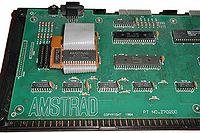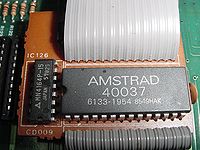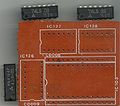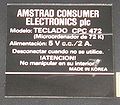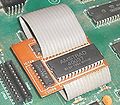Difference between revisions of "472"
(→Description) |
(→The Daughterboard) |
||
| Line 46: | Line 46: | ||
The 8KB extra memory, was a 4164 DRAM chip (64Kx1bit). The DRAMs 1bit databus didn't suit too well to the Z80s 8bit bus, moreover, the daughterboard didn't receive /RAS and /CAS signals which are usually required for DRAM addressing & DRAM refresh. So, even if it would have been functional, the RAM could have been only accessed via complicated software mechanisms; like loading the address LSBs into IR register, and then INning from address MSBs. | The 8KB extra memory, was a 4164 DRAM chip (64Kx1bit). The DRAMs 1bit databus didn't suit too well to the Z80s 8bit bus, moreover, the daughterboard didn't receive /RAS and /CAS signals which are usually required for DRAM addressing & DRAM refresh. So, even if it would have been functional, the RAM could have been only accessed via complicated software mechanisms; like loading the address LSBs into IR register, and then INning from address MSBs. | ||
| + | |||
| + | The two logic chips for address decoding (not connected, and non-functional, too) are more or less hidden under the robbon cable. Looking under it reveals a 74LS08 (Quad 2-Input NAND), and a 74LS32 (Quad 2-Input OR), as seen on Miguel Angel's photos. However, on Kevin Thacker's webpage, the second chip is listed as 74LS136 (Open-collector Quad 2-Input XOR) - so, it seems the daughterboards were randomly fitted with whatever cheaply available chips (possibly including damaged chips - ''can somebody verify that?''). | ||
== More Pictures == | == More Pictures == | ||
Revision as of 17:20, 13 April 2010
The CPC 472 was a spanish version of the CPC 464 with additional (nonfunctional) 8 KB RAM.
Contents
Description
The reason Amstrad released a special version for the spanish market was a law (RD 1250/1985) that said that every computer with up to 64KB should adhere to some rules - namely, have extra keys for the spanish language, and the video hardware had to be able to display spanish characters; otherwise an extra tax would be levied. So Amstrad soldered in an extra 8KB which was not, however, usable by the machine since it was not connected to anything else.
The tax is said to have been at least 15,000 pesetas per computer. For reference:
- 15,000 pesetas are how many? euros.
- The CPC472 itself was sold for how many? pesetas (how many? euros)
Because there was no space for a new chip, Amstrad designers took off the ROM chips, and put it in a daughter board, along with the extra 4164 RAM chip. Wires connected pins at the ROM from the daughter board to the corresponding pins on the main board. The wires were hard enough to make difficult to turn the daughter board over and reveal the trick: no wires were connected from the DRAM chip to the main board. Even the supply pins were not connected!!
The CPC 472 with spanish or british keyboard is very very rare.
In some interviews, Amstrad developers stated that they have never heard of the CPC472, so it's possible that the daughterboard was made by Indescomp (the spanish distributor), not by Amstrad.
Timeline
1. CPC464 with British Keyboard
Before the law was invented (in 1985), the normal CPC464 with english keyboard, and english CPC464 ROM (40009) may have been sold in spain.
2. CPC472 with British Keyboard
Faked 72K RAM to bypass the law. These units included a CPC664 ROM (40022) (that is, not CPC464 ROM), thus supporting Locomotive BASIC 1.1 - the spanish manual claimed that the extra 8K would be required for BASIC 1.1 - this was total nonsense, but it "explained" why users didn't have access to the extra memory: it was "reserved" for BASIC.
3. CPC472 with Spanish Keyboard
After the law was changed (now including also computers with more than 64K), the remaining CPC472 units were fitted with spanish keyboard, and spanish CPC464 ROM (40037). But still including the 72K daughterboard.
4. CPC464 with Spanish Keyboard
Once when the remaining CPC472 units were disposed, the fake 72K project was discontinued, and the CPC464 was re-invented. But now having spanish CPC464 ROM (40037) and spanish keyboard.
The Daughterboard
The picture of the desoldered MS0043A board shows the fake connections: Only the ROM (IC103) connects to the ribbon cable. The wires going to IC126,IC127,IC128 do end shortly before actually reaching the soldering points; this is hidden underneath of the white paint layer - but still visble when having a closer look. There are even a few perfectly visible interruptions that aren't covered by paint (seen near IC126).
- Daughterboard
The 8KB extra memory, was a 4164 DRAM chip (64Kx1bit). The DRAMs 1bit databus didn't suit too well to the Z80s 8bit bus, moreover, the daughterboard didn't receive /RAS and /CAS signals which are usually required for DRAM addressing & DRAM refresh. So, even if it would have been functional, the RAM could have been only accessed via complicated software mechanisms; like loading the address LSBs into IR register, and then INning from address MSBs.
The two logic chips for address decoding (not connected, and non-functional, too) are more or less hidden under the robbon cable. Looking under it reveals a 74LS08 (Quad 2-Input NAND), and a 74LS32 (Quad 2-Input OR), as seen on Miguel Angel's photos. However, on Kevin Thacker's webpage, the second chip is listed as 74LS136 (Open-collector Quad 2-Input XOR) - so, it seems the daughterboards were randomly fitted with whatever cheaply available chips (possibly including damaged chips - can somebody verify that?).
More Pictures
- CPC472
The Manual
The CPC472 came with some bizarre aspects, too. Reading 464 on the cover, but 472 on the bookneck. And, claiming that the 72K RAM would be required because of using the ROM of the CPC664 (whilst, the real CPC664 has only 64K RAM).

